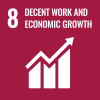
Climate change has a differential impact on people and communities. The people at greatest risk are the poor, the vulnerable and the marginalized that, in most cases, have been excluded from socioeconomic progress. Differences in wealth; unequal opportunities to access quality health services, education and employment; and inequality with respect to voice and political representation are the underpinnings of continued exposure and vulnerability of large population groups to climate hazards. Public policies have an important role to play in strengthening the capacity of people to adapt, particularly in those areas where the private sector is unlikely to invest. Policies to improve resilience to climate change are part of the larger challenge posed by sustainable development and need to address existing underlying (structural) inequalities that undermine the capacity of people to cope and adapt. Far reaching, transformative policies are needed which simultaneously address immediate vulnerabilities as well as existing structural inequalities.
Successful policies that address immediate needs as well as longer-term transformational change require robust institutions and a policy process able to identify people’s needs and give priority to building resilience among those at highest risk. Improved policy processes are also essential to implement interventions effectively, to monitor impacts, and to make the necessary adjustments in view of new information or changing conditions. The underlying uncertainty of climate change, the locality in which its effects materialize, and the interconnected nature of impacts in various sectors and development dimensions require a policymaking system that is:
- coherent, to address the socio-economic sources of inequality with consideration to the environment and a sustainable use of natural resources;
- participatory, to address the specific local context where inequalities exist and build on the unique understanding of specific risks and vulnerabilities at the local level, and;
- flexible and iterative, to cope with the inherent uncertainty of climate hazards and the need to react to new information and changing context.
Policy coherence for climate change resilience
Sustainable development and resilience are multidimensional challenges which defy single solutions. The objectives to be pursued in building climate resilience encompass multiple sectors; achieving these objectives requires substantive coordination of policy interventions within a coherent development agenda. Integrating adaptation objectives into longer-term development processes requires a careful attention to policy coherence. The challenge lies in determining how to coordinate multi-sectoral policies under a single overarching vision consistent with long-term development objectives without losing sight of immediate needs and sectoral priorities. A main concern is to go beyond providing only temporary relief against short-term shocks and to ensure that coherent policy interventions effectively address the root causes of vulnerability, thereby leading the way towards transformative adaptation strategies to enhance people’s resilience to climate hazards. This can be a challenge in a context where adaptation efforts are often compartmentalized in different sectors and decisions are made within short-term political and funding cycles. Building climate change resilience requires a continuum of well-integrated economic, social and environmental policies able to harmonize present adaptation efforts with longer-term development objectives. Achieving an optimal level of policy coherence for climate change resilience is most challenging: Impacts from climate change on people and ecosystems are complex; there remain large margins of uncertainty regarding climate change risks and policy impacts; and the institutions relevant for providing policy support typically operate with specific, often narrow mandates and short-term funding cycles. Without improved and coherent policies that provide short-term solutions consistent with long-term adaptation needs, maladaptation may arise. Maladaptation that occurs as the unintended negative effect of policies on vulnerability and the environment may result in fewer options in the future. It may also have negative effects on other communities or sectors, leading to further environmental deterioration, increased vulnerability or decreased welfare. Clearly, policy coherence for climate change resilience is most critical. Policies to reduce people’s vulnerability to climate hazards, when properly designed, can yield important benefits to advance larger development objectives, and vice versa. Realizing such co-benefits is not simple; it requires strengthen technical capacity to assess multiple policy options and a policy decision-making process that is coherent, participatory and flexible.
Ensuring equitable and meaningful participation of stakeholders
Policy coherence in practice requires direct participation of multiple stakeholders in policy decision-making. Incorporating different voices with equal importance and respect in the same policy process is not easy: these voices are often very disparate or even opposing, and are shaped by different interests and different educational and cultural backgrounds. As a consequence, some are often bypassed or curtailed in policymaking. Despite the difficulty, the involvement of stakeholders remains important, since climate hazards are felt more sharply at the local level. Improving stakeholder participation requires four conditions: (i) improving coordination across all levels of government; (ii) facilitating equitable and meaningful participation, (iii) improving valuation of local knowledge, and (iv) leveraging social networks to improve policy implementation.
Participation of local governments
The interaction between national, subnational, and local level governments is an important component of well-designed adaptation strategies. National actors are responsible for creating legal frameworks, providing information, mobilizing financial support, and protecting vulnerable groups. In this regard, they can have a large impact in promoting economic development at the local level to strengthen local communities’ capacities and resilience. Local institutions are a necessary complement by helping to coordinate and implement policies. Local agencies are also critical for improving understanding and communicating local needs and risks to national agencies.
Equitable participation of stakeholders
Inequality in political participation is at the source of vulnerability and exposure to climate hazards. Many factors— economic status, political voice, religion, culture, tradition, education—have the potential to limit the effective participation of some individuals or groups from the process, fostering inequality in political voice and influence over policy decisions. In the case of hurricane Katrina, it can be argued that the Industrial Canal that runs along the west of the Lower 9th Ward, which failed and flooded the city, was placed in that specific location due to the limited political power of the people living in that area (mostly poor African-Americans). In contrast, the districts inhabited primarily by white wealthy households had better protective infrastructure, even if their elevation was also low. Moreover, poorer and minority residents had less access to the local political processes that were involved in the recovery process. Understanding these structural inequalities is important to breaking the cycle of inequality and vulnerability.
Taking advantage of local knowledge
Because the most intense and direct effects of climate events are experienced at the local level, scoping (or identifying) objectives and risks can benefit tremendously from the accumulated knowledge of local communities. For example, local knowledge can inform technical assessments of adaptation options and vice versa. Understanding the local context also helps to avoid actions that may lead to maladaptation or incomplete solutions. In Sri Lanka, for example, the introduction of high-yielding, hybrid varieties of rice seeds had an initial beneficial effect on yields, but also eroded indigenous knowledge of the almost 2,000 traditional varieties that existed and undermined local seed banks. The new fertilizer-dependent seeds are less able to cope with the increasing water salinity in the region caused by higher temperatures, the rise of the sea level, and the failure of irrigation systems.
Taking advantage of local social capital
Policy implementation also stands to benefit when scientific groups and public agents interact more closely with local communities. Communities with high levels of social capital are likely to be more effective in circulating, for example, health and related messages. This is also critical for improving climate impact assessments, particularly in reducing uncertainty in scenario results. In the Colombian city of Manizales, for instance, national and regional authorities worked together with local communities and leaders to discourage settlement on unstable slopes that threatened livelihoods and lives. Social networks were used to launch a public awareness campaign, to explain the risks of living in dangerous land, and to design a relocation scheme. A programme to train local women on slope stabilization measures was supported by the municipal government together with local academic institutions, local technical specialists and local NGOs.
Flexibility to adjust to new information
In the context of a changing climate and greater weather variability, policymakers require flexible and iterative processes to cope with the uncertainty of climate trends and constantly changing information. The effects of climate change are constantly revised with new climate projections, impact assessments, environment statistics and even information from local stakeholders. At the same time, long-term mega trends in inequality, population growth, urbanization, economic globalization, technological change and others will interact in profound ways with climate hazards in ways that are difficult to foresee. Adaptation policy, at the same time, needs to be geographically precise since the effects of climate hazards are felt at the local level. Some problems require immediate actions to address long-term needs. Making decisions under uncertain scenarios also increases the risk of path dependence and that adaptation policy will under- or over-invest depending on the realization of climate hazards. Without a flexible plan, there is a tendency to design interventions for an average of expected outcomes that, as time progresses, prove to be either insufficient to address extreme shocks or inefficient if the shock does not materialize. In the health sector, there are many examples of low regret actions—those actions that can be justified from an economic, social or environmental perspective even if the climate hazard does not occur. Low regret actions include, among many others, the distribution of mosquito nets, improving child nutrition, developing hygiene education campaigns, and improving water and sanitation facilities. Early warning systems are another example, as they allow authorities the flexibility to act pre-emptively and adjust civil security plans, thereby reducing the number of lives at risk and/or resources used. Early warning systems are being developed as well for vector-borne and food-borne infections such as malaria and dengue in low- and middle-income countries. While low regret interventions are a good start, the implications of uncertainty to policymaking are profound. Rather than seeing adaptation actions as individual actions, it is important to see them as part of an evolving pathway where decisions are repeatedly revisited based on assessments that are also constantly revised. Policymaking processes must be organized around their ability to continuously monitor, assess and adapt to new information and changing priorities. A policy process that is able to learn and adjust is better poised to identify immediate needs and deliver transformative change.
 Welcome to the United Nations
Welcome to the United Nations


